Empirical Myoelectric Feature Extraction and Pattern Recognition in Hemiplegic Distal Movement Decoding
Abstract
1. Introduction
2. Materials and Methods
2.1. Participants
2.2. Data Acquisition and Signal Preprocessing
2.3. Universal Feature Extraction for Classification
2.4. Brute-Force Feature Selection Search
2.5. Semi-Brute-Force Navigated Amalgamation
2.6. Statistical Metrics and Evaluation
- Hudgin’s feature set or MFS1: MAV, WL, ZC, and SSC [28];
- TD-AR feature set or MFS2: RMS, and AR6 [29];
- TD-NLS feature set or MFS3: LMAV, and NSV [30];
- Du’s set or MFS4: IEMG, VAR, WL, ZC, SSC, and WAMP [31];
- NTDFS time domain set or MFS5: SSI, RSD1, RSD2, MSR, ASM, and ROG [32];
- TD-DFA feature set or MFS6: ZC, SSC, AR4, PSR, DFA, and HFD [33];
- Oskaei’s and Hu’s feature set or MFS7: MAV, RMS, WL, VAR, ZC, SSC, WAMP, MMAV1, MMAV2, PSP, AR2, AR5, MDF and MNF [24];
- Wang’s feature set or MFS8: MAV, VAR, AR-4, ZC, MNF, MDF [34];
3. Results
3.1. A Novel, Generic, Patient-Centric Method for Supervised Learning Classification
3.2. Post-Stroke Participant Characteristics
3.3. An Empirical Analysis of EMG-Oriented Features
3.4. Semi-Brute-Force Search Based on Hierarchical Feature Ranking
3.5. Statistical Comparison across the Extracted Feature Sets
4. Discussion
Supplementary Materials
Author Contributions
Funding
Institutional Review Board Statement
Informed Consent Statement
Data Availability Statement
Acknowledgments
Conflicts of Interest
Appendix A
References
- Heng, W.; Solomon, S.; Gao, W. Flexible electronics and devices as human–machine interfaces for medical robotics. Adv. Mater. 2022, 34, 2107902. [Google Scholar] [CrossRef] [PubMed]
- Maceira-Elvira, P.; Popa, T.; Schmid, A.C.; Hummel, F.C. Wearable technology in stroke rehabilitation: Towards improved diagnosis and treatment of upper-limb motor impairment. J. Neuroeng. Rehabil. 2019, 16, 142. [Google Scholar] [CrossRef] [PubMed]
- Fang, C.; He, B.; Wang, Y.; Cao, J.; Gao, S. EMG-centered multisensory based technologies for pattern recognition in rehabilitation: State of the art and challenges. Biosensors 2020, 10, 85. [Google Scholar] [CrossRef]
- Jiang, S.; Kang, P.; Song, X.; Lo, B.P.; Shull, P.B. Emerging wearable interfaces and algorithms for hand gesture recognition: A survey. IEEE Rev. Biomed. Eng. 2021, 15, 85–102. [Google Scholar] [CrossRef]
- Nikolaev, V.A.; Nikolaev, A.A. Recent trends in telerehabilitation of stroke patients: A narrative review. NeuroRehabilitation 2022, 51, 1–22. [Google Scholar] [CrossRef] [PubMed]
- Huang, H.C.; Chung, K.C.; Lai, D.C.; Sung, S.F. The impact of timing and dose of rehabilitation delivery on functional recovery of stroke patients. J. Chin. Med. Assoc. 2009, 72, 257–264. [Google Scholar] [CrossRef]
- Hatem, S.M.; Saussez, G.; Della Faille, M.; Prist, V.; Zhang, X.; Dispa, D.; Bleyenheuft, Y. Rehabilitation of motor function after stroke: A multiple systematic review focused on techniques to stimulate upper extremity recovery. Front. Hum. Neurosci. 2016, 10, 442. [Google Scholar] [CrossRef]
- Wang, C.Y.; Chen, Y.C.; Wang, C.H. Early rehabilitation in acute care inpatient wards may be crucial to functional recovery 3 months after ischemic stroke. Phys. Ther. 2021, 101, 197. [Google Scholar] [CrossRef]
- Gueye, T.; Dedkova, M.; Rogalewicz, V.; Grunerova-Lippertova, M.; Angerova, Y. Early post-stroke rehabilitation for upper limb motor function using virtual reality and exoskeleton: Equally efficient in older patients. Neurol. Neurochir. Pol. 2021, 55, 91–96. [Google Scholar] [CrossRef]
- Cesqui, B.; Tropea, P.; Micera, S.; Krebs, H.I. EMG-based pattern recognition approach in post stroke robot-aided rehabilitation: A feasibility study. J. Neuroeng. Rehabil. 2013, 10, 75. [Google Scholar] [CrossRef]
- Phinyomark, A.; Scheme, E. EMG pattern recognition in the era of big data and deep learning. Big Data Cogn. Comput. 2018, 2, 21. [Google Scholar] [CrossRef]
- Gohel, V.; Mehendale, N. Review on electromyography signal acquisition and processing. Biophys. Rev. 2020, 12, 1361–1367. [Google Scholar] [CrossRef]
- Khan, M.A.; Das, R.; Iversen, H.K.; Puthusserypady, S. Review on motor imagery based BCI systems for upper limb post-stroke neurorehabilitation: From designing to application. Comput. Biol. Med. 2020, 123, 103843. [Google Scholar] [CrossRef]
- Balasubramanian, S.; Garcia-Cossio, E.; Birbaumer, N.; Burdet, E.; Ramos-Murguialday, A. Is EMG a viable alternative to BCI for detecting movement intention in severe stroke? IEEE Trans. Biomed. Eng. 2018, 65, 2790–2797. [Google Scholar] [CrossRef]
- Azzollini, V.; Dalise, S.; Chisari, C. How does stroke affect skeletal muscle? State of the art and rehabilitation perspective. Front. Neurol. 2021, 12, 797559. [Google Scholar] [CrossRef] [PubMed]
- Campanini, I.; Disselhorst-Klug, C.; Rymer, W.Z.; Merletti, R. Surface EMG in clinical assessment and neurorehabilitation: Barriers limiting its use. Front. Neurol. 2020, 11, 934. [Google Scholar] [CrossRef]
- Jochumsen, M.; Niazi, I.K.; Zia ur Rehman, M.; Amjad, I.; Shafique, M.; Gilani, S.O.; Waris, A. Decoding Attempted Hand Movements in Stroke Patients Using Surface Electromyography. Sensors 2020, 20, 6763. [Google Scholar] [CrossRef] [PubMed]
- Li, Y.; Chen, X.; Zhang, X.; Zhou, P. Several practical issues toward implementing myoelectric pattern recognition for stroke rehabilitation. Med. Eng. Phys. 2014, 36, 754–760. [Google Scholar] [CrossRef] [PubMed]
- Abbaspour, S.; Lindén, M.; Gholamhosseini, H.; Naber, A.; Ortiz-Catalan, M. Evaluation of surface EMG-based recognition algorithms for decoding hand movements. Med. Biol. Eng. Comput. 2020, 58, 83–100. [Google Scholar] [CrossRef]
- Phinyomark, A.; Phukpattaranont, P.; Limsakul, C. Feature reduction and selection for EMG signal classification. Expert Syst. Appl. 2012, 39, 7420–7431. [Google Scholar] [CrossRef]
- Tkach, D.; Huang, H.; Kuiken, T.A. Study of stability of time-domain features for electromyographic pattern recognition. J. Neuroeng. Rehabil. 2010, 7, 21. [Google Scholar] [CrossRef] [PubMed]
- Too, J.; Abdullah, A.R.; Saad, N.M. Classification of hand movements based on discrete wavelet transform and enhanced feature extraction. Int. J. Adv. Comput. Sci. Appl. 2019, 10, 12. [Google Scholar] [CrossRef]
- Phinyomark, A.; Khushaba, R.N.; Scheme, E. Feature extraction and selection for myoelectric control based on wearable EMG sensors. Sensors 2018, 18, 1615. [Google Scholar] [CrossRef] [PubMed]
- Oskoei, M.A.; Hu, H. Support vector machine-based classification scheme for myoelectric control applied to upper limb. IEEE Trans. Biomed. Eng. 2008, 55, 1956–1965. [Google Scholar] [CrossRef] [PubMed]
- Lee, K.H.; Kung, S.Y.; Verma, N. Improving kernel-energy trade-offs for machine learning in implantable and wearable biomedical applications. In Proceedings of the 2011 IEEE International Conference on Acoustics, Speech and Signal Processing (ICASSP), Prague, Czech Republic, 22–27 May 2011; pp. 1597–1600. [Google Scholar]
- Fajardo, J.M.; Gomez, O.; Prieto, F. EMG hand gesture classification using handcrafted and deep features. Biomed. Signal Process. Control 2021, 63, 102210. [Google Scholar] [CrossRef]
- Du, S.; Vuskovic, M. Temporal vs. spectral approach to feature extraction from prehensile EMG signals. In Proceedings of the 2004 IEEE International Conference on Information Reuse and Integration, Las Vegas, NV, USA, 8–10 November 2004; pp. 344–350. [Google Scholar]
- Hudgins, B.; Parker, P.; Scott, R.N. A new strategy for multifunction myoelectric control. IEEE Trans. Biomed. Eng. 1993, 40, 82–94. [Google Scholar] [CrossRef]
- Huang, Y.; Englehart, K.B.; Hudgins, B.; Chan, A.D. A Gaussian mixture model based classification scheme for myoelectric control of powered upper limb prostheses. IEEE Trans. Biomed. Eng. 2005, 52, 1801–1811. [Google Scholar] [CrossRef]
- Islam, M.; Ahmad, S.; Haque, F.; Ibne Reaz, M.B.; Bhuiyan, M.A.; Minhad, K.N. Myoelectric pattern recognition performance enhancement using nonlinear features. Comput. Intell. Neurosci. 2022, 2022, 64144664. [Google Scholar] [CrossRef]
- Du, Y.C.; Lin, C.H.; Shyu, L.Y.; Chen, T. Portable hand motion classifier for multi-channel surface electromyography recognition using grey relational analysis. Expert Syst. Appl. 2010, 37, 4283–4291. [Google Scholar] [CrossRef]
- Samuel, O.W.; Asogbon, M.G.; Geng, Y.; Chen, S.; Feng, P.; Chuang, L.; Wang, L.; Li, G. A novel time-domain descriptor for improved prediction of upper limb movement intent in EMG-PR system. In Proceedings of the 40th Annual International Conference of the IEEE Engineering in Medicine and Biology Society (EMBC), Honolulu, HI, USA, 18–21 July 2018; pp. 3513–3516. [Google Scholar]
- Mayor, J.J.V.; Costa, R.M.; Frizera, A.; Bastos, T.F. Dexterous hand gestures recognition based on low-density sEMG signals for upper-limb forearm amputees. Res. Biomed. Eng. 2017, 33, 202–217. [Google Scholar] [CrossRef]
- Wang, N.; Chen, Y.; Zhang, X. The recognition of multi-finger prehensile postures using LDA. Biomed. Signal Process. Control 2013, 8, 706–712. [Google Scholar] [CrossRef]
- Lee, S.W.; Wilson, K.M.; Lock, B.A.; Kamper, D.G. Subject-specific myoelectric pattern classification of functional hand movements for stroke survivors. IEEE Trans. Neural Syst. Rehabil. Eng. 2010, 19, 558–566. [Google Scholar] [CrossRef]
- Zhang, X.; Zhou, P. High-density myoelectric pattern recognition toward improved stroke rehabilitation. IEEE Trans. Biomed. Eng. 2012, 59, 1649–1657. [Google Scholar] [CrossRef]
- Wang, D.; Zhang, X.; Gao, X.; Chen, X.; Zhou, P. Wavelet packet feature assessment for high-density myoelectric pattern recognition and channel selection toward stroke rehabilitation. Front. Neurol. 2016, 7, 197. [Google Scholar] [CrossRef]
- Ramos-Murguialday, A.; García-Cossio, E.; Walter, A.; Cho, W.; Broetz, D.; Bogdan, M.; Cohen, L.G.; Birbaumer, N. Decoding upper limb residual muscle activity in severe chronic stroke. Ann. Clin. Transl. Neurol. 2015, 2, 1–11. [Google Scholar] [CrossRef]
- Al-Timemy, A.H.; Khushaba, R.N.; Bugmann, G.; Escudero, J. Improving the performance against force variation of EMG controlled multifunctional upper-limb prostheses for transradial amputees. IEEE Trans. Neural Syst. Rehabil. Eng. 2015, 24, 650–661. [Google Scholar] [CrossRef] [PubMed]
- Samuel, O.W.; Zhou, H.; Li, X.; Wang, H.; Zhang, H.; Sangaiah, A.K.; Li, G. Pattern recognition of electromyography signals based on novel time domain features for amputees’ limb motion classification. Comput. Electr. Eng. 2018, 67, 646–655. [Google Scholar] [CrossRef]
- Liang, S.; Wu, Y.; Chen, J.; Zhang, L.; Chen, P.; Chai, Z.; Cao, C. Identification of gesture based on combination of raw sEMG and sEMG envelope using supervised learning and univariate feature selection. J. Bionic Eng. 2019, 16, 647–662. [Google Scholar] [CrossRef]
- Anastasiev, A.; Kadone, H.; Marushima, A.; Watanabe, H.; Zaboronok, A.; Watanabe, S.; Matsumura, A.; Suzuki, K.; Matsumaru, Y.; Ishikawa, E. Supervised Myoelectrical Hand Gesture Recognition in Post-Acute Stroke Patients with Upper Limb Paresis on Affected and Non-Affected Sides. Sensors 2022, 22, 8733. [Google Scholar] [CrossRef] [PubMed]
- Gavrishchaka, V.; Senyukova, O.; Koepke, M. Synergy of physics-based reasoning and machine learning in biomedical applications: Towards unlimited deep learning with limited data. Adv. Phys. X 2019, 4, 1582361. [Google Scholar] [CrossRef]
- Chen, K.; Zhou, F.Y.; Yuan, X.F. Hybrid particle swarm optimization with spiral-shaped mechanism for feature selection. Expert Syst. Appl. 2019, 128, 140–156. [Google Scholar] [CrossRef]
- Li, Q.; Zhang, A.; Li, Z.; Wu, Y. Improvement of EMG pattern recognition model performance in repeated uses by combining feature selection and incremental transfer learning. Front. Neurorobot. 2021, 15, 699174. [Google Scholar] [CrossRef]
- Suviseshamuthu, E.S.; Allexandre, D.; Amato, U.; Vecchia, B.D.; Yu, G.H. PROLIFIC: A Fast and Robust Profile-Likelihood-Based Muscle Onset Detection in Electromyogram Using Discrete Fibonacci Search. IEEE Access 2020, 8, 105362–105375. [Google Scholar] [CrossRef]
- Ghaleb, F.A.; Kamat, M.B.; Salleh, M.; Rohani, M.F.; Abd Razak, S. Two-stage motion artefact reduction algorithm for electrocardiogram using weighted adaptive noise cancelling and recursive Hampel filter. PLoS ONE 2018, 13, 0207176. [Google Scholar] [CrossRef] [PubMed]
- Yang, Y.; Duan, F.; Ren, J.; Liu, Z.; Zhu, C.; Soo, Y.; Mun, K. A multi-gestures recognition system based on less sEMG sensors. In Proceedings of the IEEE 4th International Conference on Advanced Robotics and Mechatronics (ICARM), Toyonaka, Japan, 3–5 July 2019; pp. 105–110. [Google Scholar]
- Venugopal, G.; Navaneethakrishna, M.; Ramakrishnan, S. Extraction and analysis of multiple time window features associated with muscle fatigue conditions using sEMG signals. Expert Syst. Appl. 2014, 41, 2652–2659. [Google Scholar] [CrossRef]
- Mobarak, M.P.; Salgado, J.M.G.; Guerrero, R.M.; Dorr, V.L. Transient state analysis of the multichannel EMG signal using Hjorth’s parameters for identification of hand movements. ICCGI 2014, 2014, 37. [Google Scholar]
- Cai, Y.; Guo, Y.; Jiang, H.; Huang, M.C. Machine-learning approaches for recognizing muscle activities involved in facial expressions captured by multi-channels surface electromyogram. Smart Health 2018, 5, 15–25. [Google Scholar] [CrossRef]
- Namazi, H. Decoding of hand gestures by fractal analysis of electromyography (EMG) signal. Fractals 2019, 27, 1950022. [Google Scholar] [CrossRef]
- Mengarelli, A.; Tigrini, A.; Fioretti, S.; Cardarelli, S.; Verdini, F. On the use of fuzzy and permutation entropy in hand gesture characterization from emg signals: Parameters selection and comparison. Appl. Sci. 2020, 10, 7144. [Google Scholar] [CrossRef]
- Taghizadeh, Z.; Rashidi, S.; Shalbaf, A. Finger movements classification based on fractional fourier transform coefficients extracted from surface emg signals. Biomed. Signal Process. Control 2021, 68, 102573. [Google Scholar] [CrossRef]
- She, H.; Zhu, J.; Tian, Y.; Wang, Y.; Yokoi, H.; Huang, Q. SEMG Feature Extraction Based on Stockwell Transform Improves Hand Movement Recognition Accuracy. Sensors 2019, 19, 4457. [Google Scholar] [CrossRef]
- Donovan, I.M.; Puchin, J.; Okada, K.; Zhang, X. Simple space-domain features for low-resolution sEMG pattern recognition. In Proceedings of the 2017 39th Annual International Conference of the IEEE Engineering in Medicine and Biology Society (EMBC), Jeju Island, Republic of Korea, 11–15 July 2017; pp. 62–65. [Google Scholar]
- Jiang, S.; Li, L.; Xu, H.; Xu, J.; Gu, G.; Shull, P.B. Stretchable e-skin patch for gesture recognition on the back of the hand. IEEE Trans. Ind. Electron. 2019, 67, 647–657. [Google Scholar] [CrossRef]
- Zhang, T.Y.; Tao, C.J. The comparison and analysis of SEMG in upper limb movement between hemiplegic patients and healthy people. Appl. Mech. Mater. 2015, 719, 969–972. [Google Scholar] [CrossRef]
- Fujita, K.; Kobayashi, Y.; Hitosugi, M. Temporal changes in electromyographic activity and gait ability during extended walking in individuals post-stroke: A pilot study. Healthcare 2021, 9, 444. [Google Scholar] [CrossRef]
- Tan, M.G.; Ho, J.H.; Goh, H.T.; Ng, H.K.; Latif, L.A.; Mazlan, M. Revealing stroke survivor gait deficits during rehabilitation using ensemble empirical mode decomposition of surface electromyography signals. Biomed. Signal Process. Control 2020, 61, 102045. [Google Scholar] [CrossRef]
- Orhani, S. Fibonacci Numbers as a Natural Phenomenon. Int.J. Sci. Res. Innov. Technol. 2022, 1, 7–13. [Google Scholar]
- Tran-Ngoc, H.; Le-Xuan, T.; Khatir, S.; De Roeck, G.; Bui-Tien, T.; Abdel Wahab, M. A promising approach using Fibonacci sequence-based optimization algorithms and advanced computing. Sci. Rep. 2023, 13, 3405. [Google Scholar] [CrossRef]

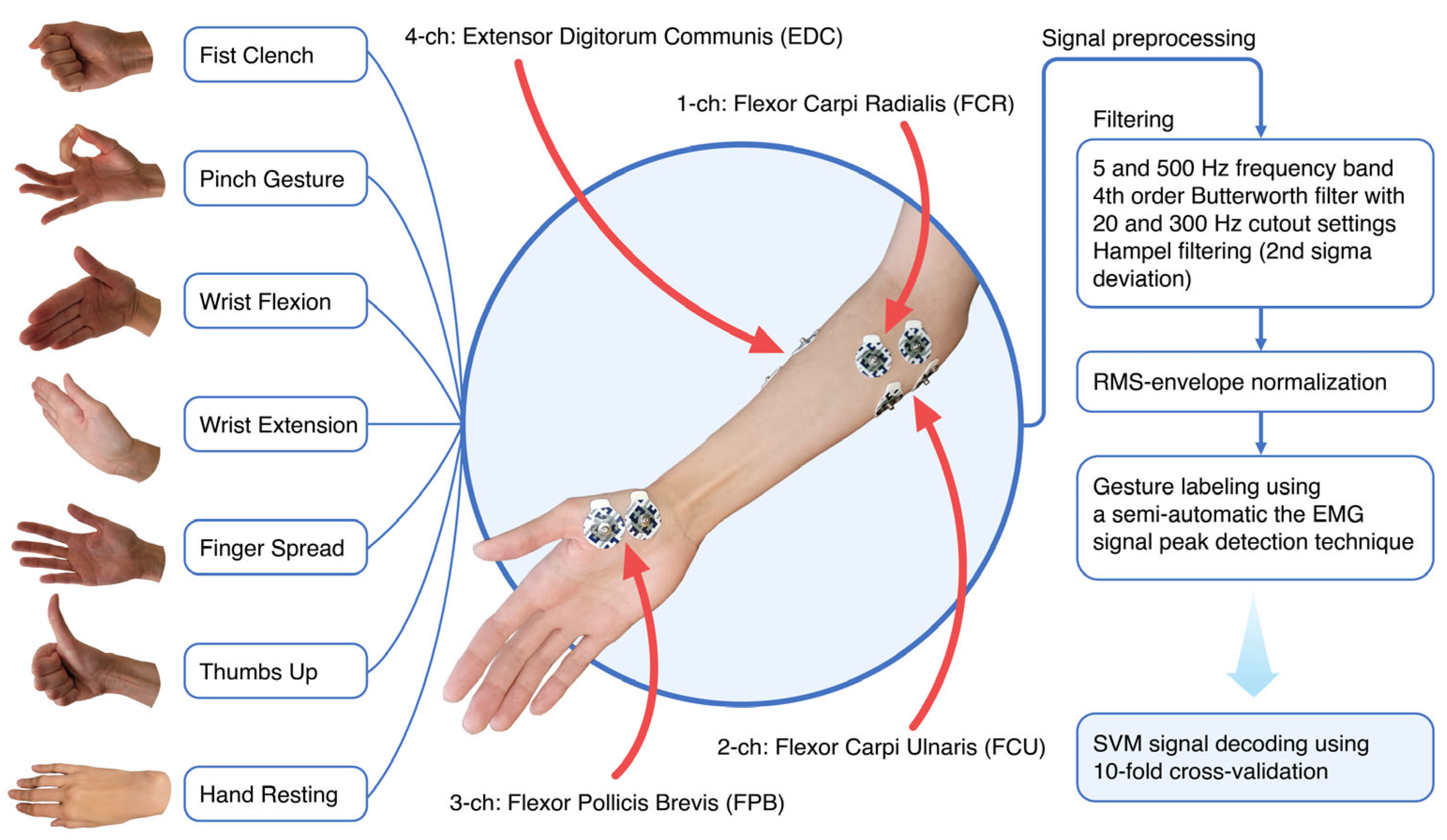
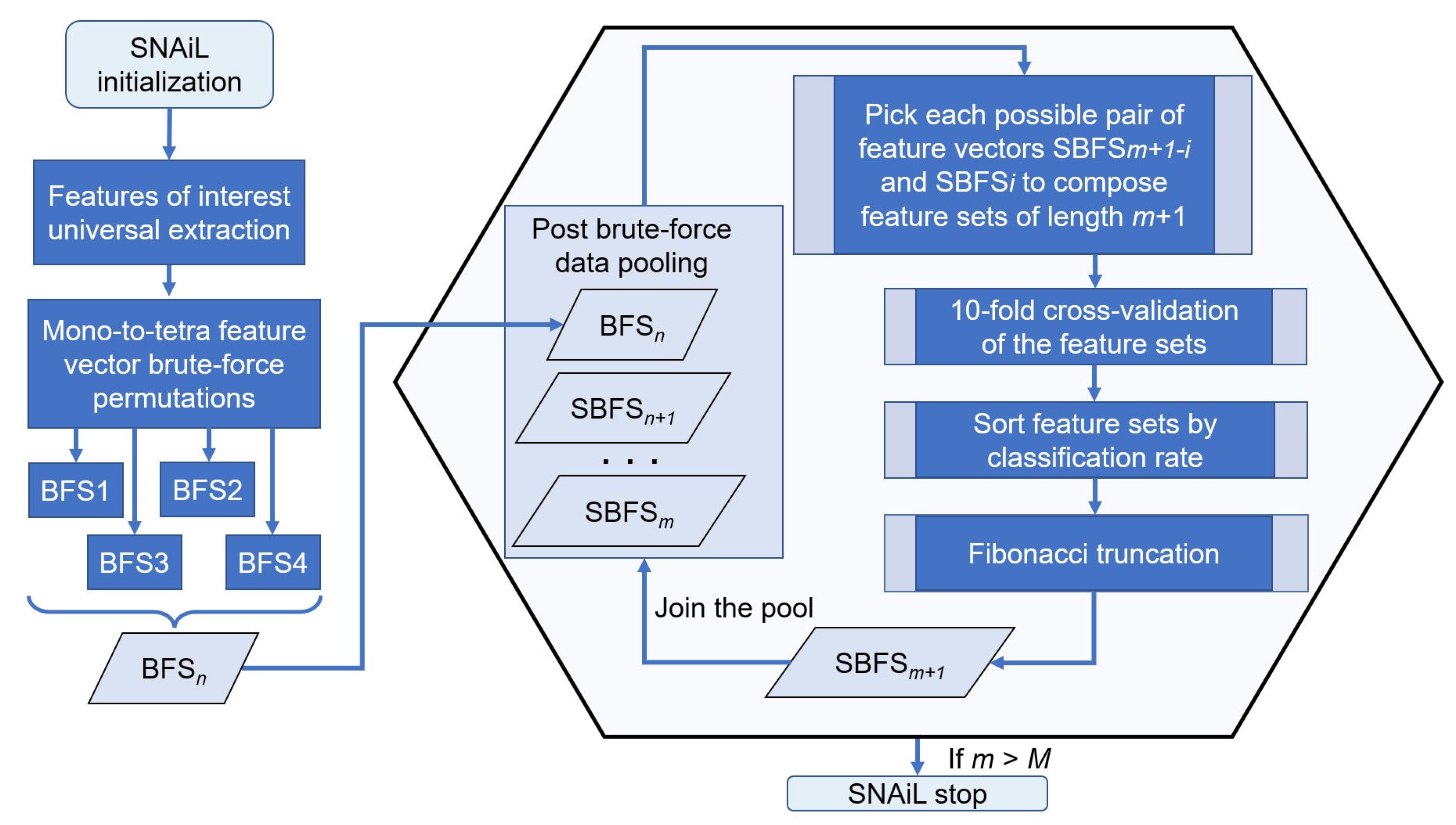
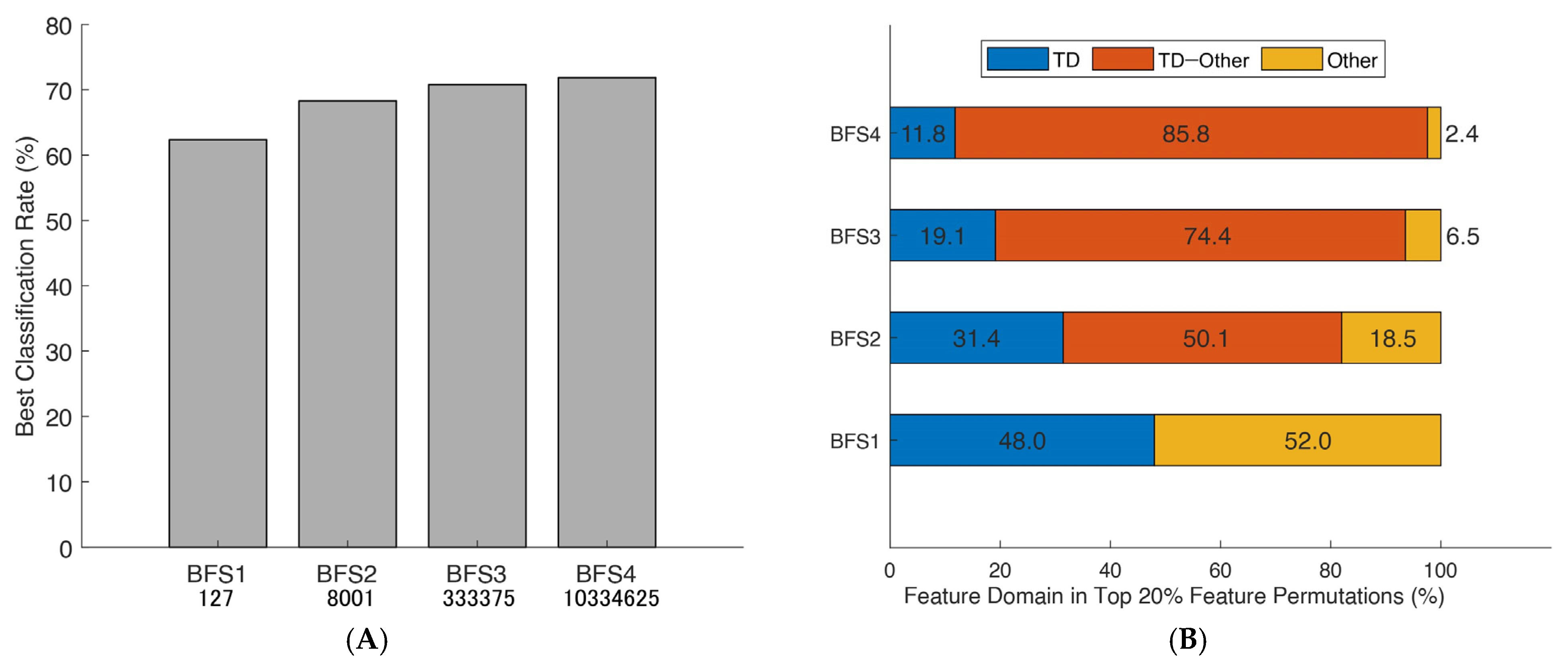
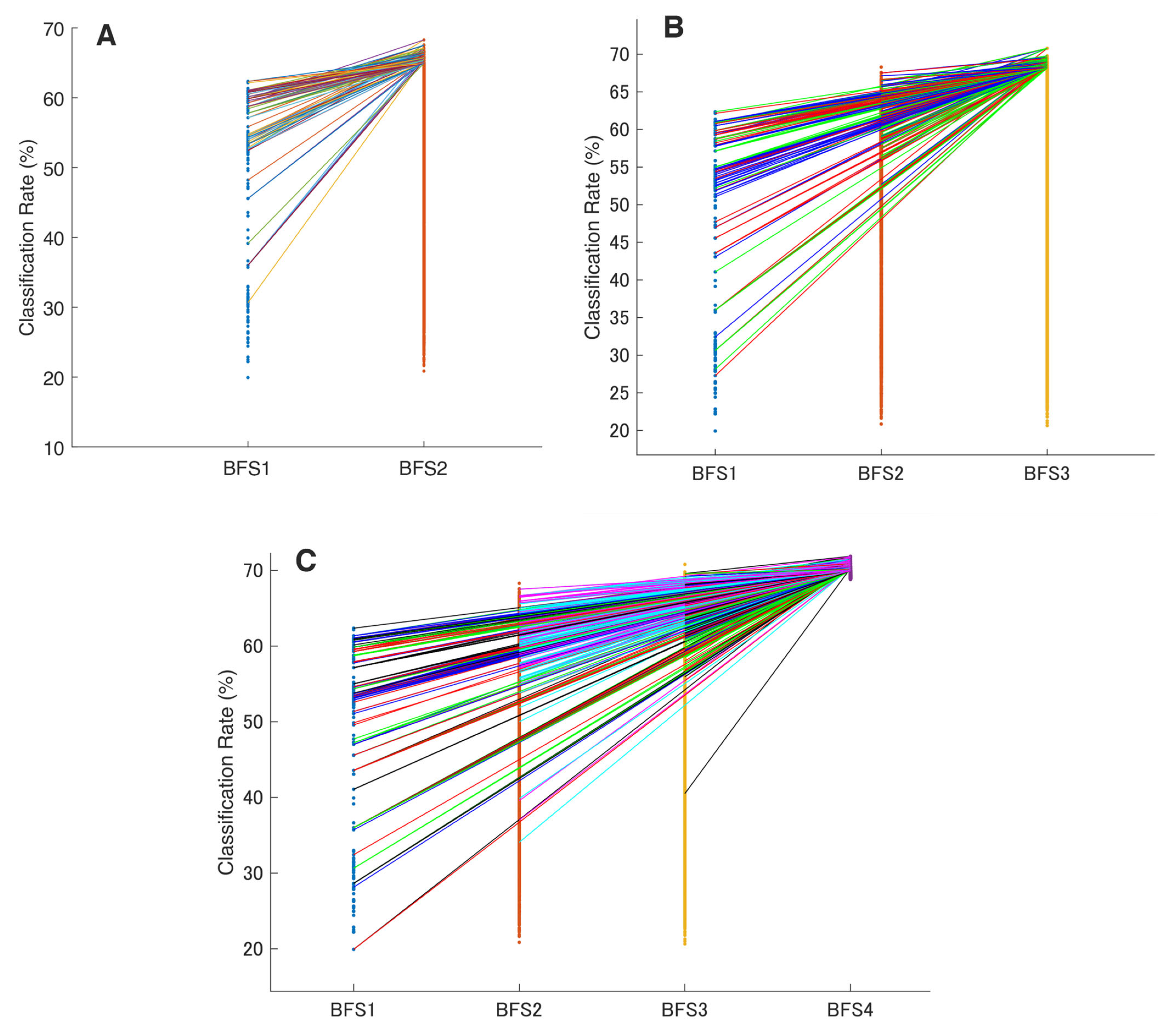
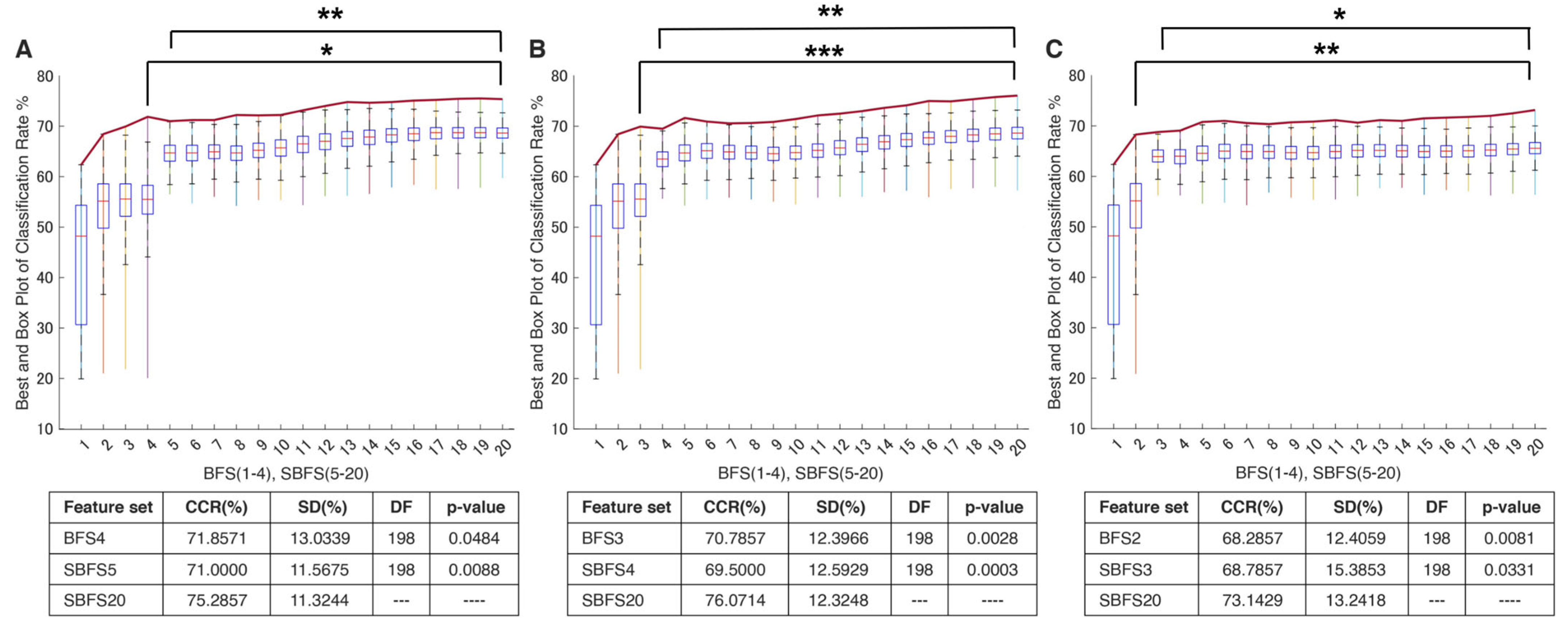

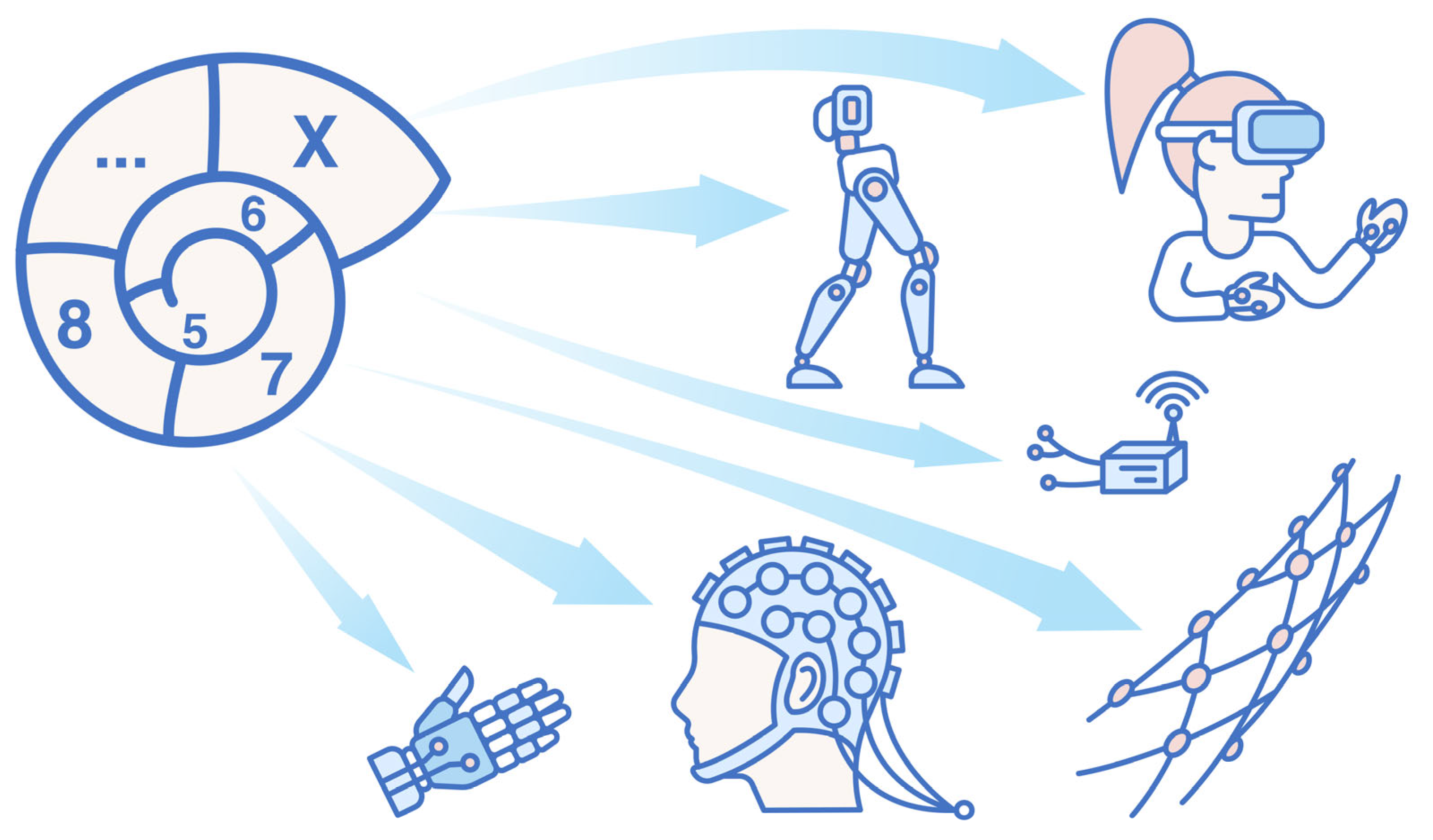
| Participant Specifications | Data and Scores |
|---|---|
| Age, AV ± SD | 65.9 ± 12.4 |
| Gender, n (%) | |
| Male | 12 (63.2) |
| Female | 7 (36.8) |
| Race, n (%) | |
| Asian | 19 (100) |
| Onset, days, AV ± SD | 12.4 ± 6.3 |
| Lesion characteristics, n (%) | |
| Cerebral infarction (CI) | 11 (57.9) |
| Intracranial hemorrhage (ICH) | 8 (42.1) |
| Affected side, n (%) | |
| Right | 11 (57.9) |
| Left | 8 (42.1) |
| Motor impairment scales | |
| FMA-UE (from 0 to 66) scores, AV ± SD | 40 ± 20 |
| SIAS-M (from 0 to 5), AV ± SD | [3 ± 1, 3 ± 2] |
| Brunnstrom stage (from 1 to 6), AV ± SD | [4 ± 1, 4 ± 1] |
| Hospitalization facilities, n (%) | |
| Stroke Care Unit (SCU) | 14 |
| Hospital ward | 5 |
| Feature Set | CCR (%) | SD (%) | DF | p-Value |
|---|---|---|---|---|
| Best of SBFS | 76.0714 | 12.3248 | --- | --- |
| Best of BFS | 71.8571 | 13.0339 | 198 | 0.0198 * |
| MFS1 | 60.5714 | 12.3710 | 198 | 4.1523 × 10−16 **** |
| MFS2 | 50.4286 | 16.2382 | 198 | 4.7378 × 10−27 **** |
| MFS3 | 54.0000 | 15.9661 | 198 | 4.2208 × 10−22 **** |
| MFS4 | 60.6429 | 12.7814 | 198 | 1.3719 × 10−15 **** |
| MFS5 | 61.2143 | 11.3169 | 198 | 4.0690 × 10−16 **** |
| MFS6 | 54.7857 | 11.0775 | 198 | 7.2799 × 10−28 **** |
| MFS7 | 52.8571 | 14.6068 | 198 | 9.8525 × 10−26 **** |
| MFS8 | 57.0000 | 14.8163 | 198 | 5.1484 × 10−19 **** |
Disclaimer/Publisher’s Note: The statements, opinions and data contained in all publications are solely those of the individual author(s) and contributor(s) and not of MDPI and/or the editor(s). MDPI and/or the editor(s) disclaim responsibility for any injury to people or property resulting from any ideas, methods, instructions or products referred to in the content. |
© 2023 by the authors. Licensee MDPI, Basel, Switzerland. This article is an open access article distributed under the terms and conditions of the Creative Commons Attribution (CC BY) license (https://creativecommons.org/licenses/by/4.0/).
Share and Cite
Anastasiev, A.; Kadone, H.; Marushima, A.; Watanabe, H.; Zaboronok, A.; Watanabe, S.; Matsumura, A.; Suzuki, K.; Matsumaru, Y.; Ishikawa, E. Empirical Myoelectric Feature Extraction and Pattern Recognition in Hemiplegic Distal Movement Decoding. Bioengineering 2023, 10, 866. https://doi.org/10.3390/bioengineering10070866
Anastasiev A, Kadone H, Marushima A, Watanabe H, Zaboronok A, Watanabe S, Matsumura A, Suzuki K, Matsumaru Y, Ishikawa E. Empirical Myoelectric Feature Extraction and Pattern Recognition in Hemiplegic Distal Movement Decoding. Bioengineering. 2023; 10(7):866. https://doi.org/10.3390/bioengineering10070866
Chicago/Turabian StyleAnastasiev, Alexey, Hideki Kadone, Aiki Marushima, Hiroki Watanabe, Alexander Zaboronok, Shinya Watanabe, Akira Matsumura, Kenji Suzuki, Yuji Matsumaru, and Eiichi Ishikawa. 2023. "Empirical Myoelectric Feature Extraction and Pattern Recognition in Hemiplegic Distal Movement Decoding" Bioengineering 10, no. 7: 866. https://doi.org/10.3390/bioengineering10070866
APA StyleAnastasiev, A., Kadone, H., Marushima, A., Watanabe, H., Zaboronok, A., Watanabe, S., Matsumura, A., Suzuki, K., Matsumaru, Y., & Ishikawa, E. (2023). Empirical Myoelectric Feature Extraction and Pattern Recognition in Hemiplegic Distal Movement Decoding. Bioengineering, 10(7), 866. https://doi.org/10.3390/bioengineering10070866










